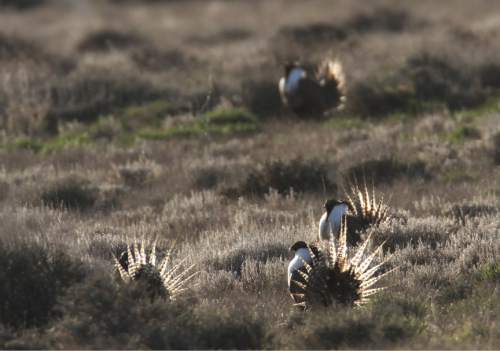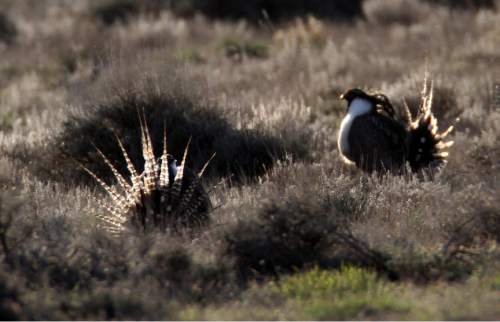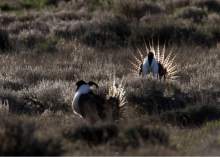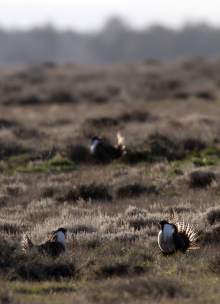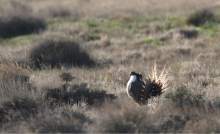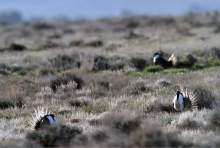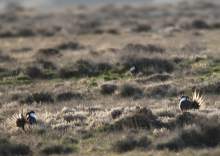This is an archived article that was published on sltrib.com in 2014, and information in the article may be outdated. It is provided only for personal research purposes and may not be reprinted.
The Gunnison sage grouse will be listed as threatened under the federal Endangered Species Act, the U.S. Fish and Wildlife Service announced Wednesday.
The listing was a downgrade from an earlier agency recommendation — and an acknowledgement of work by Native American tribes, private land owners and state wildlife officials in Colorado and Utah to cut threats to the bird in an effort to avoid an endangered listing.
"Efforts by Utah and Colorado, private landowners and tribes have reduced the threats to the bird," said wildlife service director Dan Ashe. "These investments and protections that have been put in place will pay enormous dividends in the future."
Wednesday's announcement left conservationists and state wildlife managers disappointed, but for different reasons. Utah wildlife officials wanted no federal protection and the wildlife conservation groups wanted an endangered listing.
The listing comes with an option for a special rule that allows federal officials to relax some ESA restrictions to allow ranchers, farmers and landowners in Colorado and Utah committed to grouse conservation to continue their practices without new restrictions.
Gunnison sage grouse were recognized as a separate species from Greater sage grouse in 2000 and were soon after designated as a candidate for listing under the ESA.
A small percentage of the estimated 4,700 Gunnison sage grouse population live in two areas in San Juan County near Monticello. The majority of the birds live in southwestern Colorado, but the entirety of the species is found in just 7 to 12 percent of its historic range.
Conservation advocates say "threatened" status does not provide enough protection for the birds.
"Imperiled by irresponsible grazing, oil and gas drilling, residential development, roads, power lines and the cumulative impacts of these threats, the fewer than 5,000 remaining Gunnison sage grouse need the strongest possible protections to ensure they survive and recover," said Erik Molvar, wildlife biologist with WildEarth Guardians. "The science is clear: This spectacular dancing bird is endangered and should be afforded the highest level of protection."
Utah Division of Wildlife Resources Director Greg Sheehan, however, says more can be done to protect the birds without a federal listing.
"Placing the bird under the oversight of the federal government will greatly reduce our ability to help the bird," Sheehan said. "Putting the bird under the management authority of the federal government will create roadblocks that will make it difficult to complete work to help the species."
The Fish and Wildlife Service also is designating 1.4 million acres of critical habitat — some unoccupied historic territory and some currently occupied — it deems necessary for the recovery of Gunnison sage grouse.
The critical habitat designation, according to FWS, only affects actions on the land by federal agencies and does not restrict access to or activities on private land.
While Utah and Colorado have made impressive efforts to restore the species, Ashe said, the Fish and Wildlife Service is bound to make listing decisions based on the best available science.
"The law asked us to consider the current and foreseeable future," he said. "We believe the best science points that while not facing an imminent risk of extinction, which would warrant an endangered listing, a threatened listing under the Endangered Species Act is the appropriate conclusion."
Colorado Gov. John Hickenlooper indicated earlier this week his state would sue if the U.S. Fish and Wildlife Service listed the grouse as endangered or threatened.
The birds, according to the Fish and Wildlife Service, historically were found in the Four Corners area of Colorado, Utah, Arizona and New Mexico.
Gunnison sage grouse are about 1/3 smaller than Greater sage grouse and males show distinct, white barring on their tail feathers.
Eleven western states are undergoing massive conservation and planning efforts as the Fish and Wildlife Service faces a September 2015 deadline for a decision whether to list the greater sage grouse as threatened.
Ashe said Wednesday the decision on Gunnison sage grouse should not be considered an indication of how a decision on the Greater sage grouse might shake out.
Those involved with efforts to keep the Greater sage grouse listed agree.
"There really are not a lot of parallels with the Greater and the Gunnison," said Tim Griffiths, national coordinator for the Sage Grouse Initiative. "We are talking about 5,000 birds instead of 500,000. The scope is very different."
The fact the Fish and Wildlife Service recognized efforts by the states, local governments and landowners to work on protecting the Gunnison sage grouse could be encouraging to those working on the larger effort.
"The decision on the Gunnison sage grouse should not deter responsive management efforts for the Greater sage grouse, and the time to act is now," said Ed Arnett, director of the TRCP Theodore Roosevelt Conservation Partnership) Center for Responsible Energy Development. "Adequate resources and political will is needed from all parties to keep the Greater sage grouse from being listed as a threatened species."
Coincidentally, Salt Lake City is hosting the International Sage Grouse Forum Thursday and Friday at the Radisson Hotel.
Utah Gov. Gary Herbert will address the group as will Tom Tidwell, chief of the U.S. Forest Service and representatives of the Bureau of Land Management, U.S. Fish and Wildlife Service.
Herbert was not excited about Wednesday's announcement.
"It's always better to work together toward a solution than to use a heavy hand. Listing the Gunnison sage grouse as threatened is a step backward for the conservation effort, for the economy and for the constructive relationship we have tried to develop with all stakeholders," he said in a news release.
Utah awarded a $2 million contract in May to a lobbyist to discourage listing the Greater sage grouse as threatened.
Twitter: @BrettPrettyman —
See a video of Gunnison sage grouse




